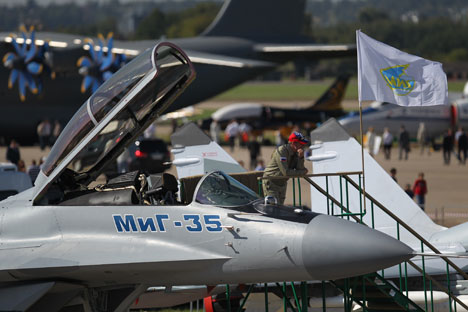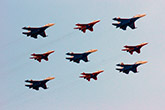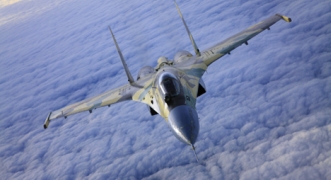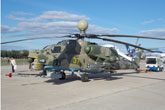MAKS-2013 lived up to and surpassed expectations

The Mikoyan MiG-35 is a further development of the MiG-29 technology. Source: Sergei Mikheev
From the very beginning, organizers of MAKS-2013 announced that this year’s airshow would become a unique event and surpass other world-renowned airshows in a number of ways. Records were expected in terms of both visitor numbers and elements of the flying program.
The forecasts proved to be correct: According to preliminary figures, on Aug. 31 alone (the peak day for visitors), numbers reached more than 165,000 people. This is a record number in the entire history of MAKS. The population of Zhukovsky, where the airshow took place, is around 100,000 people.
The majority of visitors came to MAKS because of the unique flying program. The huge viewing area to one side of the runway, as well as almost the entire exhibition area (on the days when it was open to all visitors), was full of people. Those who were not able to find a place in the viewing area used all accessible natural and unnatural vantage points, including the steps for nearby aircraft in the park.
There was much to see. The fifth generation T-50 PAK-FA fighters were the highlight of the flying display. This aircraft had been demonstrated to visitors before—but only one model, and without performing aerobatic maneuvers. A trio of aircraft performed a display this time. Immediately after the flying display by the three aircraft, the decorated Hero of the Russian Federation and test pilot of the T-50, Sergei Bogdan, performed a six-minute aerobatic display.
Aside from the innovations from the aeronautical sector, the organizers of MAKS included historic exhibits in the static display this year. Almost all the well-known, Soviet-era aircraft were on show. Among them was the supersonic Tu-144 passenger airliner, which never entered service with Soviet airlines and which airshow visitors were able to look around at their leisure. Another example of Soviet technology was the huge VM-T Atlant transport aircraft. In the ‘80s, this was used to transport missile and space technology from the manufacturer’s airfields to the Baikonur Cosmodrome.
The world’s largest passenger aircraft—the Airbus A-380—also took part in the flying display. Despite the airliner’s huge size and weight, the A-380 deftly kept all its turns well within the airfield boundary. Due to clouds, the giant aircraft had to perform at low level, making its maneuvers even more impressive.
A surprise for visitors was the display by the People’s Liberation Army Air Force display team, “1st of August.” The team was named after the anniversary of the formation of the Chinese People’s Liberation Army. Chinese aircraft had never performed at any of the other open-aviation events in Russia. The 1st of August pilots brought five of their high-speed, fourth-generation, J-10 fighters, which were fitted with Russian engines.
To MAKS regulars, who are used to aerobatic maneuvers performed by Russian, American and European teams, the display by the Chinese team may have appeared unusual: The difference in style was noticeable, and not just to specialists. No one can say that the Chinese flew their aircraft better or worse than the Russians or Europeans, as much as they somehow flew in their own way—the Chinese way.
The display by the well-known Russian aerobatic display teams—“Russkiye Vityazi” (Russian Knights) and the “Strizhi” (Swifts)—drew the greatest adoration from the crowd. Russkiye Vityazi is the only aerobatic display team in the world that operates the Su-27P and Su-27UB heavy fighters. The Strizhi operate the highly maneuverable, multi-role MiG-29.
The expanded helicopter program was also a feature of MAKS-2013. The debut display by the Russian Air Force aerobatic display team, the “Berkuty” (Golden Eagles), flying the Mi-28N attack helicopter was especially successful. This is one of the few helicopter teams in the world that demonstrates maneuvers at average and high levels of complexity, in both vertical and horizontal planes at exceptionally low levels.
The display by the Mi-2 helicopter was a real masterpiece of aerobatics. Watching the pilot’s virtuoso performance and the routine he performed, viewers got the impression that he had learned how to temporarily switch off gravity.
Despite the fact that MAKS is traditionally considered an aviation exhibition, considerable space was given over to aviation’s true antagonists—air defense systems. Specifically, this was not the first time that the Club-K container missile system was exhibited at the show. The system is made to look like an ordinary sea container, but a launch assembly with four cruise missiles is stored inside. In its assembled form, it is practically impossible to distinguish it from thousands of other containers.
A prototype of the manned, re-usable transport spacecraft RKK Energiya (exhibited at MAKS-2013 at the Roscosmos pavilion) was a space systems innovation. According to its manufacturers, the spacecraft incorporates all the most modern technical solutions and developments, which allow it to compete with the Orion developed in the United States. The spacecraft is designed for nine cosmonauts and a 1,100-pounds payload. It has been proposed that this spacecraft could also be used to take people to the Moon.
These were, however, just one percent of the innovations presented at MAKS-2013. The number of technical exhibits gathered together in the pavilions numbered in the thousands. If all this is anything to go by, new records are to be expected of the next MAKS, which will take place in 2015.
All rights reserved by Rossiyskaya Gazeta.
Subscribe
to our newsletter!
Get the week's best stories straight to your inbox


